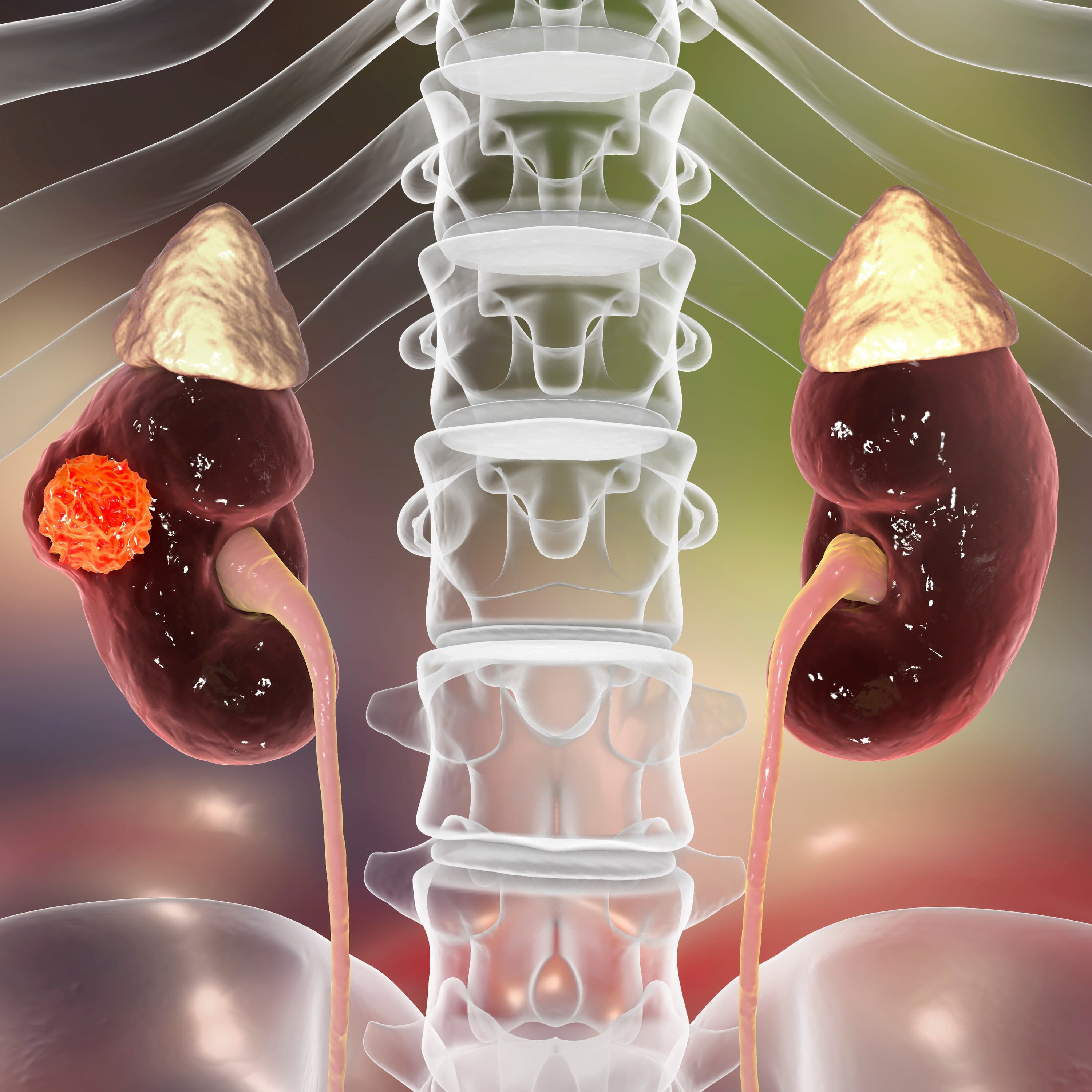Neoadjuvant Immunotherapy May Help Improve Disease Control in RCC
In patients with metastatic renal cell carcinoma, neoadjuvant immunotherapy–based combinations yielded reductions in tumor size and pathologic necrosis at the time of cytoreductive nephrectomy.
“Decreasing the extent of the IVC [inferior vena cava] thrombus and pathological downstaging with perioperative IO [immuno-oncology]–based therapies improves complexity of nephrectomy,” lead study author Damla Gunenc said.

According to findings from a retrospective, single-center analysis from the University of Texas Southwestern Medical Center presented in a poster at the 2023 Kidney Cancer Research Summit, neoadjuvant immunotherapy–based combinations led to reductions in tumor size and pathologic necrosis at the time of cytoreductive nephrectomy in patients with metastatic renal cell carcinoma (RCC).
At a median follow-up of 21 months, 42% (n = 16) of patients experienced pathologic T downstaging, 11% (n = 4) of whom had pT0 disease. Thrombus downstaging occurred in 13% (n = 6) of patients, all of whom achieved partial response or complete response in metastatic lesions. Notably, 2 patients with synchronous bilateral renal masses underwent staged radical nephrectomy and nephron-sparing partial nephrectomy after neoadjuvant treatment with immunotherapy.
“Decreasing the extent of the IVC [inferior vena cava] thrombus and pathological downstaging with perioperative IO [immuno-oncology]–based therapies improves complexity of nephrectomy,” lead study author Damla Gunenc, of the Department of Internal Medicine, Division of Hematology and Oncology, at UT Southwestern in Dallas, Texas, and coauthors, wrote in the poster.
With the development of frontline immunotherapy-based combinations in metastatic RCC, the role of cytoreductive nephrectomy has come into question.
“We will offer cytoreductive nephrectomy up-front on a multidisciplinary discussion. It requires a urologist and a medical oncologist to discuss the patient characteristics. Often those patients who undergo cytoreductive nephrectomy first, in our current practice, are the patients who have the bulk of their tumor burden in the primary tumor. This is often 80% to 90% of their total tumor burden, and patients [should be] surgically fit, good candidates,” senior study author Tian Zhang, MD, associate professor in the Department of Internal Medicine at UT Southwestern Medical Center, said in an interview.
As such, this single-center, retrospective study evaluated 51 patients who underwent cytoreductive nephrectomy between April 2016 and October 2022. Patients with stratified by whether they received up-front surgery or delayed surgery following up-front immunotherapy.
The primary end point of the study was pathologic tumor size reduction and downstaging. Secondary end points were progression-free survival (PFS) and overall survival (OS).
Median age was 62 years (range, 36-86) and most were male, White, and had not received any treatment prior to starting immunotherapy.
In the up-front surgery cohort, mean age was 59.62 years, and most patients were male (76.9%), White (92.3%), had clear cell histology (76.9%), and had received ipilimumab (Yervoy) plus nivolumab (Opdivo; 61.5%). Additional treatment regimens included pembrolizumab (Keytruda) plus lenvatinib (Lenvima; 7.7%), and nivolumab or pembrolizumab alone (30.8%). More than half of patients in this cohort experienced tumor necrosis (53.8%).
In the delayed surgery cohort, mean age was 62.53 years, and most patients were male (76.3%), White (81.6%), had clear cell histology (89.5%), and had received ipilimumab plus nivolumab (63.2%). Other treatment regimens included pembrolizumab plus axitinib (Inlyta; 15.8%), pembrolizumab plus lenvatinib, and nivolumab monotherapy. Additionally, 76.3% of patients experienced tumor necrosis.
Additional results demonstrated that PFS (HR, 0.7; 95% CI, 0.29-1.98; P =.58) and OS (HR, 0.4; 95% CI, 0.13-1.57; P = .21) trended in favor of up-front immunotherapy. However, the results were not statistically significant.
Disease characteristics before and after neoadjuvant therapy were also presented for the cohort of patients who received up-front immunotherapy, showing median tumor size reduction from 10 cm to 7.5 cm (P < .05). T stages before and after treatment, respectively, included T0 (0% vs 10.5%), T1 (5.3% vs 13.2%), T2 (13.2% vs 7.9%), T3 (52.6% vs 57.9%), and T4 (28.9% vs 10.5%; overall, P < .05).
Thrombus level before and after treatment, respectively, included 0 (13.2% vs 5.3%), 1 (13.2% vs 10.5%), 2 (13.2% vs 7.9%), 3 (2.6% vs 7.9%), 4 (5.3% vs 5.3%), and no thrombus (52.6% vs 63.2%; overall, P < .05).
N stage before and after treatment, respectively, included N0 (60.5% vs 71.1%), N1 (39.5% vs 13.2%), and Nx (not available [NA] vs 15.8%; overall, P = .374). Clinical M stage before and after treatment, respectively, included M0 (NA vs 50%), M1 (100% vs 47.4%), and unknown (NA vs 2.6%; overall, P < .001).
“Effective IO-VEGF based therapies administered prior to nephrectomy have promising potential in disease control. Randomized trials [such as the phase 3 PROBE trial (NCT04510597)] are ongoing to investigate the timing and outcomes of cytoreductive nephrectomy for patients with metastatic RCC,” study authors concluded.
Reference
Gunenc D, Gerald T, Issa W, et al. Pathological response and outcomes of patients with metastatic renal cell carcinoma undergoing cytoreductive nephrectomy after immunotherapy regimens. Presented at: 2023 Kidney Cancer Research Summit; July 13-14, 2023; Boston, MA. Abstract 90.